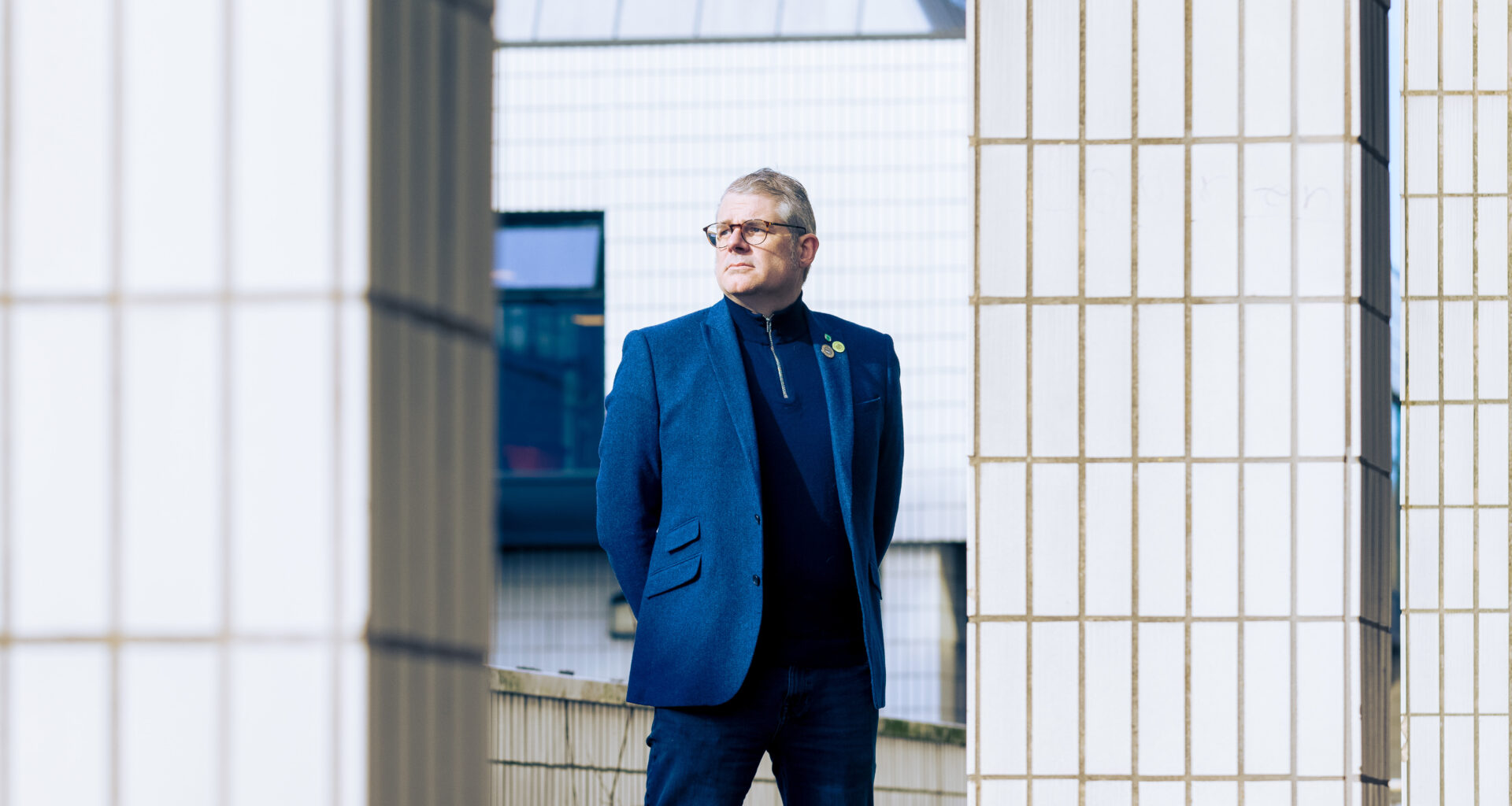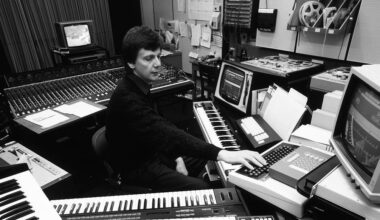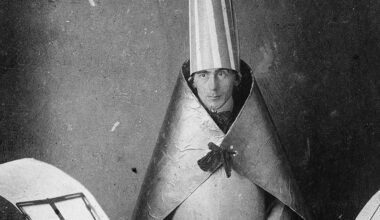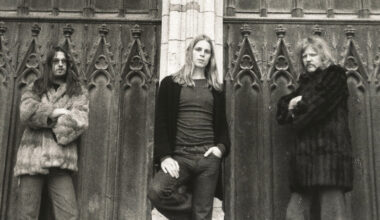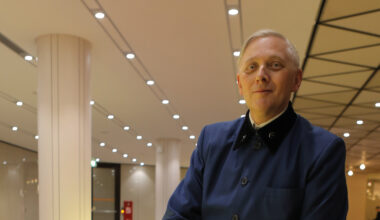Concrete dreams and brutalist ideals… Gordon Chapman-Fox is Warrington-Runcorn New Town Development Plan. His third album, ‘Districts, Roads, Open Space’, has just been released and he’s here to talk about it. What’s more, he’s brought sandwiches
“They do ‘The Hobbit’ here in the summer,” says Gordon Chapman-Fox, sitting on a park bench and taking a bite from a ham sandwich. “The Dukes Theatre puts it on. Those trees over there are The Shire, and the memorial itself is Lonely Mountain, where the dragon lives.”
We’re in Williamson Park in Lancaster with our packed lunches. I’ve brought prawn cocktail crisps and a Wispa Gold. Behind us looms the Ashton Memorial, a towering, green-domed (and reputedly haunted) Edwardian folly, while the trees before us frame spectacular mist-shrouded views of an autumnal Morecambe Bay. If this is Middle-earth, the elves talk like Thora Hird and eat hotpot for breakfast. But the use of public spaces for creative leisure? Entirely on-message.
In his slightly unwieldy guise as Warrington-Runcorn New Town Development Plan, Chapman-Fox has crafted three albums of affectingly utilitarian synth instrumentals since 2020, all concerned with the intricacies of 1970s Lancashire urban planning, specifically the utopian dreams of the “new towns” of North-West England, with their concrete shopping arcades and brutalist bus stations.
His latest offering, ‘Districts, Roads, Open Space’, is strikingly evocative of an era when local councillors with comb-overs would loftily promise the hard-working families of Skelmersdale that, by the year 1995, they’d be whizzing to the shops on a monorail.
“The first album, ‘Interim Report, March 1979’, was very much based on buildings,” explains Chapman-Fox. “And the second, ‘People & Industry’, is pretty self-explanatory, but this one is more about the lives led within the new towns. It coincided with a particularly low point during lockdown, when I was feeling very isolated, quite lonely and adrift.
“It seemed to tie in with how artificial the new towns felt, with designated areas for shopping, leisure and work, because human life isn’t that structured. It’s far more messy and organic. In the 70s, there was still a culture of men going out to work and their wives staying at home, and I felt sorry for all those women trapped in their houses day after day. So it was a kinship through lockdown with what they must have gone through.”
The actual Warrington-Runcorn New Town Development Plan was real, resulting in the ambitious, concrete-fuelled 1970s expansion of both places. And Chapman-Fox’s childhood was spent at the heart of a proposed development which, if ambitious plans had ever come to fruition, would have brought together three neighbouring outposts into a similarly sprawling metropolis. It was the beginning of his fascination.
“Preston, Leyland and Chorley were going to become Central Lancashire New Town,” he recalls. “The idea was abandoned, and only a few business parks and one new housing estate were built, but I knew kids that lived there. And a couple of hills away was Skelmersdale New Town…
“These places seemed exotic, but also quite alien and distant. You drive along a road, you come to a roundabout. You drive along another road and you come to another roundabout, you know? Where is everything? You can see houses in the distance, but you don’t know how to get to them. It felt futuristic but artificial – like the Moonbase from ‘Space: 1999’.”
We’re now walking up the hill to the cafe attached to the butterfly house. Cyclists, joggers and mums with mitten-wearing kids are eating scones around tables that rattle in the breeze. I’m keen to explore the chasm between the space-age visions of the 1970s planners, genuinely determined to remove northern families from the poverty of crumbling slums, and the eventual reality of piss-soaked concrete underpasses.
“There’s that famous photo of Ena Sharples standing on a high-rise and looking out over the tenements of Salford,” says Chapman-Fox. “That photograph encapsulates so much. Runcorn had the Southgate Estate, the most brutalist of the new estates, but it lasted barely 13 years before it was demolished. For a council to do something so radical, then pull it down a decade later [shakes his head]… I think my music actually sits in that gap. Between the attempts to make things better and the fact that, in some cases, they actually ended up worse.”
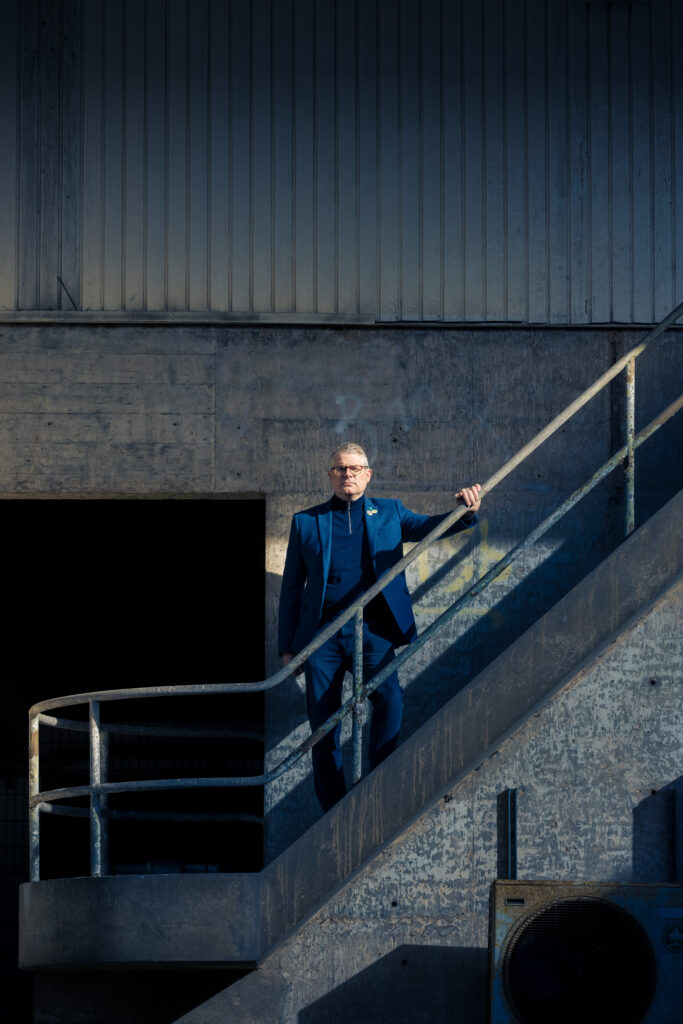
So what went wrong?
“Well, the Southgate Estate was just bad design. They had one oil-based heating system for the whole complex, so the blocks near the centre were roasting and the rest were freezing cold. It might have looked fantastic to anyone who appreciates brutalism, but the practicalities were appalling.
“And growing up, I often went to Preston on the bus. You can buy tea towels of Preston bus station now – ‘Look, it’s a design classic!’ – but I only remember the underground subway to the shopping centre. There’d always be homeless people sleeping in there, and a desperate, dire busker. The floors had a rubber covering that stuck to your shoes because every liquid known to mankind had been spilt on it. There certainly wasn’t any appreciation of brutalism in the 1980s and 90s. It was very much viewed as a mistake.”
It wasn’t always the case, though. Settling outside the cafe, I cite that great sociological case study, the 1976 film version of the classic sitcom, ‘The Likely Lads’. It perfectly encapsulates, I suggest, a seismic class difference when it comes to northern views of modernist salvation.
In one scene, Bob Ferris and Terry Collier stand amid the freshly razed rubble of their terraced childhood homes. For the upwardly mobile and bouffantly quiffed Bob, already living in the middle-class suburbs, the high-rise apartments emerging from these ruins are “soulless concrete blocks”. For the resolutely working-class Terry, the redevelopment can’t come soon enough. Here is a man justifiably tired of “padding down the yard to a freezing outside bog”.
“Yes, I do think there was a lot of that feeling,” agrees Chapman-Fox. “People wanted to move forward. The Runcorn New Town master plan was devised by Arthur Ling, who was vice-president of the Royal Institute of British Architects and a committed communist. Not just a socialist – a member of the Communist Party. He very much saw Runcorn New Town as a way of improving the lives of ordinary people.”
Did Thatcherism eventually scupper these developments, then? I have detected a sliver of anger running through the Warrington-Runcorn albums. Bitterness at these ideals of northern working-class redemption being failed by the incoming Tory administration.
Chapman-Fox is nodding in agreement as a waitress in a black tabard brings us a piping hot pot of tea.
“Managed decline was a definite policy and will feed into the themes of the next album,” he says. “We’ve had wave after wave of ‘Northern Powerhouse’ and ‘Levelling Up’ campaigns – they’re all hot air and empty promises. So where the third album is alone and adrift, there’s a lot of anger in the fourth. The treatment of the provinces and the North in particular. That’s the whole debate, really – did the new towns fail or were they failed? And in a lot of cases, I think it’s the latter, through lack of investment.
“But I try to convey hope and despair simultaneously. And I do love brutalism as a style. In the 1980s, we suddenly got housing estates that looked like the Dursleys’ house in the Harry Potter books, trying to be rustic villages.
“The 1979 election of Margaret Thatcher feels like a turning point where we stopped looking forward and actually started looking backwards. Poundbury, built by the now-King Charles on the outskirts of Dorchester, is horrendous – very much a new town estate designed to look like Georgian architecture. There’s even a town square with a bandstand. It just makes me think of ‘Trumpton’.”
So what about the upbringing of the teeny Gordon Chapman-Fox? Mum was a primary school teacher with copies of the ‘Come And Praise’ hymn book piled on the piano stool, but it was his electrical engineer dad who provided a more profound musical education.
“He had a colossal record collection,” recalls Chapman-Fox. “All the original Beatles releases until ‘Magical Mystery Tour’, when I think things got a bit too weird for him. But hearing ‘Sgt Pepper’ as a five-year-old created such vivid pictures in my head. He had a huge classical collection too, which included ‘Switched-On Bach’ by Wendy Carlos. And also, crucially, he had ‘Oxygène’ and ‘Equinoxe’ by Jean-Michel Jarre. So I would put those on, get out my ‘Star Wars’ figures and have the greatest fun.
“The electronic music from TV programmes like ‘The Great Egg Race’ and ‘Chock-A-Block’ would be filtered in too. And anything that the BBC Radiophonic Workshop was doing on ‘Doctor Who’. It all percolated through into my consciousness.”
Wasn’t that music born from similarly altruistic ambitions as the new town projects? It’s a conceptual leap, but go with me on this. The BBC, publicly funded and with a remit unbound by commerce, deciding it would be healthy to give ordinary kids a blast of the avant-garde – experimental electronic noise, tape loops and the humming of wave oscillators – on your telly every Saturday teatime?
“Yeah,” he laughs. “And, of course, they were only paying for one guy in a cupboard, which is far cheaper than an orchestra. That was the whole idea behind the synth sounds on the Warrington-Runcorn albums. If a local authority was producing a promotional film about their proposed new town development, they’d get one bloke with three synths and a four-track machine and say, ‘Make us some music’.”

His first synth, he reveals, was bought in the 1990s and employed in a somewhat unlikely musical setting.
“I was with a band called Narcosis, putting samples and noises into grindcore!” he laughs. “But really, I got into electronic music around 2000 when a mate brought me a dodgy copy of a piece of software called Reason. And part of the appeal came from me being a control freak. I love being in a band and bouncing ideas off each other, but sometimes I’d say, ‘This song should do this!’, and no one else would agree.”
Further alarming forays into grindcore were made during a stint as bassist with Lancashire noiseniks Mechagodzilla. There are recordings on YouTube that sound like angry elephants being pushed down flights of stairs. Chapman-Fox also bashfully admits to having made a modest amount of commercial music for local TV adverts. Which ones? He’s reluctant to say, but I prod him with the milk jug until he relents.
“There’s a caravan site over the hill there,” he says, vaguely wafting an arm in the direction of Carnforth. “Holgates Holiday Parks. I’ve done them.”
Everything about Warrington-Runcorn New Town Development Plan feels perfectly formed, the result of Chapman-Fox’s own visionary ambitions for his music. The immaculate blocks of analogue, the council-issue synths and the self-designed album artwork, redolent of local authority pamphlets stuffed into revolving display racks in pebble-dashed libraries.
Live, he is accompanied by projections of smoke-filled local council meetings – Arthur Ling with his trimmed moustache and the blocky text of ancient Granada TV adverts. Tellingly, Chapman-Fox’s day job is designing graphics for the marketing department of Lancaster University, three miles up the A6 on a sprawling, modernist campus.
“The fact that I work at the university goes into the whole brutalism mix,” he nods. “It’s not full-on concrete, but it’s still very 1960s. It’s almost a new town in itself.”
So was the whole Warrington-Runcorn project sparked by his frustration at his previous lack of musical success? He blithely claims his earlier solo electronic incarnations – Heskin Radiophonic and Dublock – never sold more than 30 copies of any release. Was ‘Interim Report, March 1979’ a deliberately contrary “Fuck you”? A project so achingly specialist that it surely wouldn’t sell at all… but which, in accordance with the bizarre laws of the universe, actually did?
“Definitely,” he smiles. “I make the music for a principal audience of me. Which may be egotistical, but if you’re not happy with your own music, why would anyone else like it? The whole theme of the Warrington-Runcorn New Town Development Plan is exceptionally niche, so much so that I’ve possibly painted myself into a corner.”
Still, the success has been a blast. There are at least two more Warrington-Runcorn albums in the pipeline and a further LP under his own name. This summer, he played to a packed-out tent at the End Of The Road festival in Dorset’s Larmer Tree Gardens. The Financial Times described the performance, with appropriately minimalist brevity, as “one middle-aged man and his electronics set-up”.
He laughs self-effacingly at the review.
“Part of me is still in a daze,” he admits. “To have played to 1,000 people… it was amazing. I felt as confounded as I did when the first pressing of ‘Interim Report, March 1979’ sold out in minutes. It was intimidating, so much bigger than anything I’d ever done before, and I think I looked up twice. During the first break in my set, I went over to the microphone to introduce myself, but I stumbled, nearly fell over, and just went, ‘Ta!’ Then I spent the next 10 minutes thinking, ‘You utter tit…’.”
And with that, we drain the last of the tea and wander back down the hill. Just as in Middle-earth, the road leads ever on and on. Not to Rivendell and Mordor, but to Dalton Square and the White Cross pub, and the musical dreams of a very Lancastrian utopia.
‘Districts, Roads, Open Space’ is out on Castles In Space
